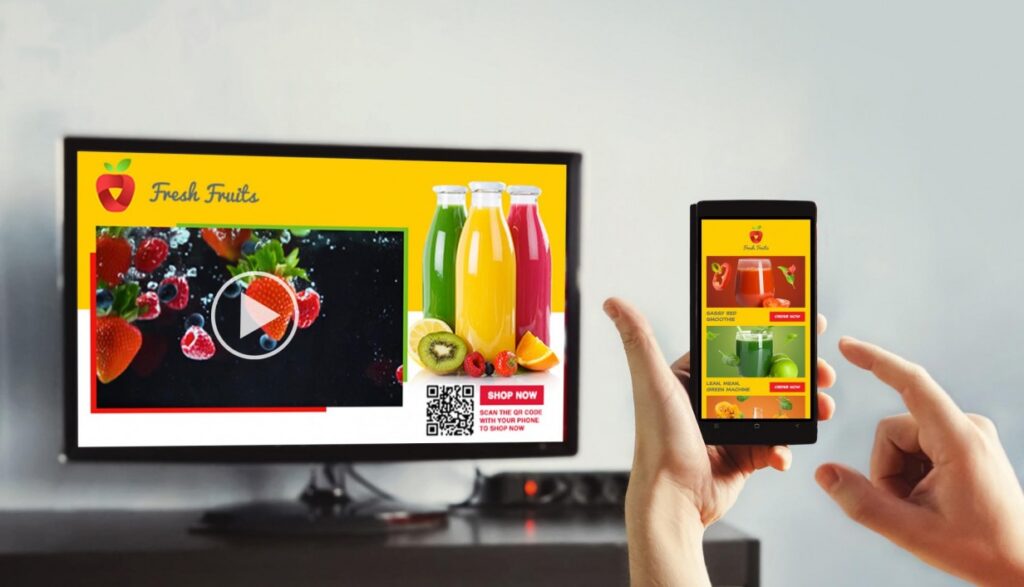The age of interactive multimedia is here, bringing images and videos that you can click and explore. This new way of media is changing how Americans watch and interact with digital content. It’s making them more than just viewers.
Now, American audiences can take part in the content they see online. This change is big for how we learn, get news, and connect with each other in the U.S.
Multimedia tools let Americans be part of the online content they see. This means the difference between watching and making content is getting smaller. Now, educational sites and news articles use interactive features to make learning and staying updated more engaging.
Key Takeaways
- Interactive media is changing how Americans watch and take part in digital content, moving from just watching to being active.
- Multimedia tools are changing how Americans learn, get news, and interact with digital content.
- Interactive media is greatly affecting how we take in information, enjoy entertainment, and communicate in the U.S.
- This new media is making the gap between watching and creating content smaller, letting audiences take part in what they see.
- Things like educational sites and news articles are using interactive features to make learning and staying updated more fun.
The Rise of Interactive Multimedia
The digital world has changed a lot, thanks to interactive media. This type of media lets users engage with the content directly. It’s more than just looking at pictures or watching videos. It includes things like clicking on things, finding information, and getting a personalized experience.
Defining Interactive Media
Interactive media is all about letting users take part in the content they watch or read. It’s different from old-school media that you just sit back and watch. This new kind of media makes the experience more fun and tailored to you.
The Multimedia Effect: Visual Learning
Interactive multimedia is getting popular because it helps people learn better. Studies show that using pictures and interactive stuff helps you remember things faster than just reading text. In fact, pictures are 60,000 times quicker to process than words.
Color pictures also catch your eye more, keeping your attention 42% better than black and white ones. This shows how good interactive media and multimedia are at sharing information. Most people learn better through visuals and interactivity.
“The ability to engage with digital content in an interactive way has revolutionized how audiences consume and retain information.”
More digital platforms are making it easier for people to get involved with content. As technology gets better, making fun and visually appealing content will become even easier. This makes interactive media more important in sharing stories and information.
Interactive Media in News and Journalism

Nowadays, multimedia like images, videos, and interactive parts are key in news and journalism. They make the news more engaging and let readers take part in the story. This breaks down the old wall between the news and the people reading it.
Multimedia Use in News Content
More than half of journalists say they prefer news releases with multimedia or interactive parts. These new ways of sharing news help keep readers interested. People spend over 6 minutes with each interactive news release.
Interactive Assets for Information Discovery
Interactive multimedia, like clickable maps and video players, make news more fun and personal. They let readers dive into the story at their own pace. This way, they can focus on what interests them most.
“Incorporating interactive elements breaks down the traditional barrier between the viewer and the content, inviting the audience to become active participants in the information discovery process.”
The move to more interactive news comes from what readers want: engaging stories with lots of multimedia. As technology gets better, interactive media will play an even bigger role in journalism.
Engaging with Interactive Media
Interactive media has changed how we connect with content. Things like video, infographics, and virtual reality grab our attention. This has led to people spending more time with these interactive pieces, often over 6 minutes. This is way more than what people usually spend with old-school media.
This longer time spent with content is great for brands and creators. It lets them share info, build brand awareness, and help people absorb information better. These interactive elements make people want to explore more, diving deep into the content to learn something new.
The Power of Interactive Engagement
Why are people spending more time with interactive media? Here are a few reasons:
- Being interactive helps people remember and understand info better because they’re part of the content.
- Things like dynamic infographics and interactive videos really grab people’s attention and make them want to look closer.
- Being able to control how fast they go through content makes users feel more in charge, making them more interested in what they’re learning.
Using interactive engagement, brands and creators can really get their message out there. They can make people more aware, help them absorb more info, and build strong connections with their audience.
| Interactive Asset | Average Engagement Time |
|---|---|
| Interactive Infographics | 6 minutes 15 seconds |
| Interactive Videos | 8 minutes 32 seconds |
| Virtual Reality Experiences | 10 minutes 47 seconds |
These numbers show how big of an effect interactive media has on people. They highlight the huge chance for brands and creators to really grab their audience’s attention and create strong engagement.
Interactive Media
The Role of Technology Advancements
The fast growth of technology advancements has boosted interactive media. Now, with smart devices everywhere, people have 24/7 access to lots of multimedia content. These technologies keep getting better, making the multimedia they carry more interactive.
Thanks to ubiquitous access, people can control their learning and find information on their own. They can now interact with content in new ways, like changing visuals and joining in on stories. This makes people more engaged and helps them have a deeper, more personal experience.
“The more capable technology becomes, the more the multimedia it carries will evolve and become more interactive.”
As technology advancements change the world of interactive media, we’ll see new, exciting ways to enjoy multimedia. From virtual reality to AI-powered personalization, the multimedia evolution is set to change how we interact with information and fun.
Cultivating Social Awareness with Interactive Media
Interactive media is a key tool for building social awareness and getting people involved in their communities. A study from Thailand shows how this approach can change things. It used things like augmented reality, games, and digital stories to make people care about road safety.
This toolkit was used in schools and communities. It made people more aware and got them to take action. The interactive parts of the media made learning fun and deep. This helped people feel connected to the problems they could solve.
“The White-Road Social Awareness Toolkit demonstrated the transformative potential of interactive media in cultivating social awareness and inspiring community-driven solutions. By seamlessly blending technological innovation with impactful storytelling, we were able to engage and empower citizens to become active stakeholders in addressing crucial societal issues.”
This study shows how interactive media can really make a difference. As technology gets better, we’ll have more ways to use it for good. This could lead to big changes in society, thanks to people working together online.
Interactive Advertising and Consumer Engagement

Interactive advertising is now key for brands wanting to grab consumers’ attention. By adding interactive parts, ads aim to make people pay more attention and understand product claims better. It’s important to know how well these ads work by looking at how people interact with them.
Evaluating Consumer Engagement Metrics
Researchers look at different ways to see how people interact with ads. These include:
- Time spent viewing the ad
- User navigation through interactive content
- Click-through rates
- Social interactions, such as sharing or commenting
This data helps us understand how well ads engage people and if they work well.
Impact on Comprehension of Product Claims
Studies have looked into how interactive ads affect people’s understanding of product claims. Some say more interactivity helps people remember and understand better. But others think too many interactive parts can make it harder to get the message. This shows the need for careful design in ads, especially for products that need clear information.
| Metric | Description | Impact on Comprehension |
|---|---|---|
| Time Spent Viewing | The duration of time a consumer spends engaging with an interactive ad | Increased time spent can lead to better recall and understanding of product claims, but excessive interactivity may distract from key information |
| User Navigation | The level of interactivity and exploration of interactive content by the consumer | Higher levels of navigation can enhance comprehension, but complex interfaces may overwhelm users and hinder information retention |
| Click-Through Rates | The percentage of consumers who click on interactive elements within an ad | Click-through rates can indicate engagement, but do not necessarily correlate with improved comprehension of product claims and risk disclosures |
| Social Interactions | The level of sharing, commenting, or other social engagement with an interactive ad | Social interactions may enhance brand awareness and engagement, but do not directly measure the impact on consumer understanding of product information |
As ads keep changing online, knowing how interactive ads, consumer engagement, and understanding product info work together is key. Brands need to get this right to talk to their audience well.
The Multimedia Effect in Learning

Many studies show that the “multimedia effect” greatly improves learning and remembering information. Most people learn better with visuals and interactivity than just text.
Students do better when learning materials mix text with pictures, graphics, and interactive parts. This shows how multimedia and interactivity help in learning. They make learning more effective and keep knowledge in our minds longer.
Visual and Interactive Learning Styles
Our brains handle visual info better than just text. Interactive learning makes us more involved with the content. This makes learning through visual learning and interactive learning more powerful.
- Studies reveal that visual info sticks with us 65%, while text alone keeps only 10%.
- Things like simulations, animations, and quizzes make students more engaged and keep knowledge for up to 60% longer.
Using multimedia and interactive parts in learning makes a big difference. It boosts how well we process information and does wonders for grades. The multimedia effect is a key to making learning fun and effective.
Also Read : Top 10 Television Shows That Are Trending In The USA
Conclusion
Interactive media has changed how Americans interact with digital content, entertainment, education, and communication. Thanks to tech advances, people now take an active role in finding information. This shift has made learning more engaging and effective.
Interactive ads have had mixed results, but interactive media boosts social awareness and community ties. As tech gets better, interactive media’s role in entertainment, education, and communication will grow. Americans are embracing this tech, making it key to how we learn and interact online.
Interactive media has opened new ways for people to engage, learn, and connect. As tech keeps improving, we’ll see more creative uses and better experiences. This means interactive media’s impact on Americans will keep growing and changing.
FAQs
Q: What are the different forms of interactive media that impact American audiences?
A: Interactive media encompasses various forms including games and interactive media, immersive experiences, and digital technology that engage users actively, influencing their perceptions and interactions.
Q: How can I start a career in interactive media?
A: To pursue a career in interactive media, consider enrolling in an interactive media program that offers a bachelor’s degree in areas like interactive media design, game design, or user experience design, which will equip you with the necessary technical skills.
Q: What should I expect from an interactive media program?
A: An interactive media program typically covers various subjects such as game development, web design, media production, and user experience, preparing students for careers in the media arts and related fields.
Q: What role does user experience play in interactive media?
A: User experience is crucial in interactive media as it focuses on creating engaging and intuitive interfaces that enhance the overall interaction with digital media products, such as games and interactive experiences.
Q: What skills are essential for someone in game design?
A: Essential skills for game design include technical skills in programming, graphic design, user interface design, and an understanding of user experience to create compelling games and interactive experiences.
Q: What is the significance of an interactive media degree in today’s job market?
A: An interactive media degree is significant as it opens up various career paths, such as media specialist, project manager, or roles in digital marketing, where knowledge of interactive media and digital technology is highly valued.
Q: Can you describe the relationship between interactive media and digital marketing?
A: Interactive media and digital marketing are interconnected, as interactive experiences can enhance user engagement and brand interaction, making campaigns more effective and memorable through games and interactive media elements.
Q: How does user interface design affect interactive media?
A: User interface design is critical in interactive media as it directly impacts how users interact with a product, influencing their overall experience and satisfaction with games and other forms of interactive media.
Q: What are the career prospects for graduates of an interactive media major?
A: Graduates of an interactive media major have promising career prospects in various fields such as game development, web design, media production, and user experience design, all of which are increasingly in demand in the digital landscape.
Q: What is the importance of project management in interactive media development?
A: Project management is important in interactive media development as it ensures that projects are completed on time, within budget, and meet the desired objectives, facilitating effective collaboration among teams working on digital media projects.




